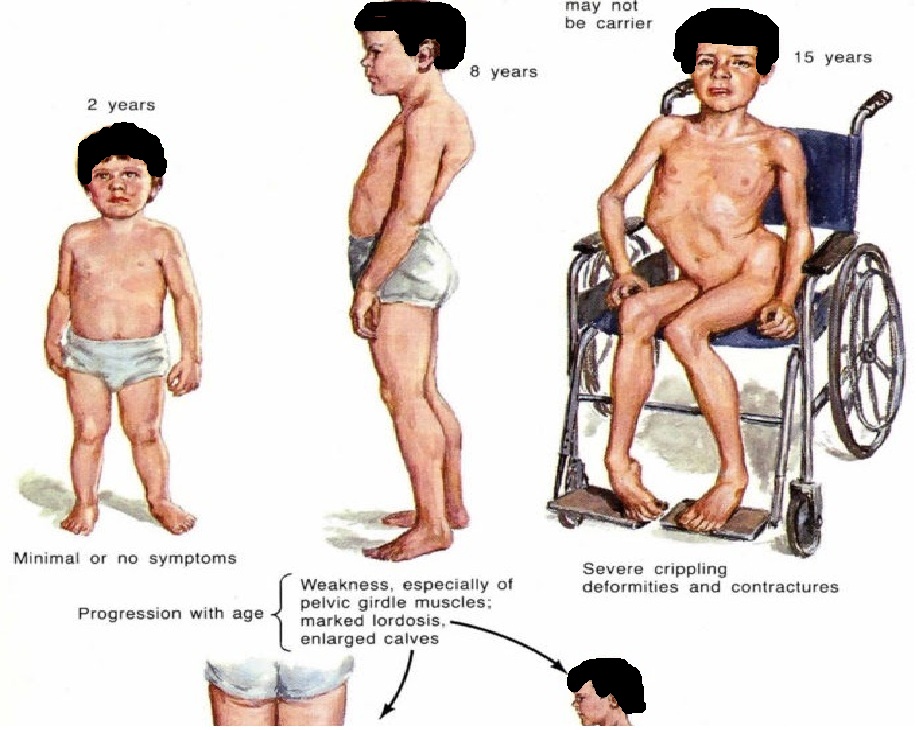Muscular dystrophy (MD)
Muscular dystrophy (MD) is a group of genetic diseases that cause progressive muscle weakness and degeneration. Muscular dystrophy is a group of diseases that cause progressive weakness and loss of muscle mass. In muscular dystrophy, abnormal genes (mutations) interfere with the production of proteins needed to form healthy muscle.
Kinds of muscular dystrophy
Duchenne muscular dystrophy,
Myotonic muscular dystrophy,
Becker muscular dystrophy,
Congenital muscular dystrophy,
Facioscapulohumeral muscular dystrophy,
Limb-girdle muscular dystrophy.
Duchenne muscular dystrophy (MD)
This is the most common form. Although girls can be carriers and mildly affected, it’s much more common in boys.

Signs and symptoms of Duchenne Muscular Dystrophy
Typically appear in early childhood
Frequent falls
Difficulty rising from a lying or sitting position
Trouble running and jumping
Waddling gait
Walking on the toes
Large calf muscles
Muscle pain and stiffness
Learning disabilities
Delayed growth
Myotonic muscular dystrophy (MD)
This is characterized by an inability to relax muscles following contractions. Facial and neck muscles are usually the first to be affected. People with this form typically have long, thin faces; drooping eyelids; and swanlike necks.
Becker muscular dystrophy (MD)
Signs and symptoms are similar to those of Duchenne muscular dystrophy, but tend to be milder and progress more slowly. Symptoms generally begin in the teens but might not occur until the mid-20s or later.
Congenital muscular dystrophy (MD)
This type affects boys and girls and is apparent at birth or before age 2. Some forms progress slowly and cause only mild disability, while others progress rapidly and cause severe impairment
Facioscapulohumeral muscular dystrophy (MD)
Muscle weakness typically begins in the face, hip and shoulders. The shoulder blades might stick out like wings when arms are raised. Onset usually occurs in the teenage years but can begin in childhood or as late as age 50.
Limb-girdle muscular dystrophy (MD)
Hip and shoulder muscles are usually affected first. People with this type of muscular dystrophy might have difficulty lifting the front part of the foot and so might trip frequently. Onset usually begins in childhood or the teenage years.
Symptoms of Muscular dystrophy (MD)
Muscle pain and stiffness,
Frequent falls,
Difficulty rising,
Trouble running and jumping,
Waddling gait
Walking on the toes
Causes of Muscular dystrophy (MD)
MD is caused by gene mutations that affect muscle proteins. These mutations are usually inherited, but can also occur spontaneously.
Diagnosis of Muscular dystrophy (MD)
A muscle biopsy or DNA blood test can confirm a diagnosis.
Other tests may include
Electrocardiography (ECG),
Nerve Conduction Study,
Electromyography (EMG), and
Urine and Blood Laboratory Investigations.
Progression of Muscular dystrophy (MD)
MD is a progressive condition that worsens over time.
It can affect
Skeletal and cardiac muscles, and can lead to reduced mobility,
Respiratory complications,
Cardiac complications.
Complications of Muscular dystrophy (MD)
Trouble walking. Some people with muscular dystrophy eventually need to use a wheelchair.
Trouble using arms. Daily activities can become more difficult if the muscles of the arms and shoulders are affected.
Shortening of muscles or tendons around joints (contractures). Contractures can further limit mobility.
Breathing problems. Progressive weakness can affect the muscles associated with breathing. People with muscular dystrophy might eventually need to use a breathing assistance device (ventilator), initially at night but possibly also during the day.
Curved spine (scoliosis). Weakened muscles might be unable to hold the spine straight.
Heart problems. Muscular dystrophy can reduce the efficiency of the heart muscle.
Swallowing problems. If the muscles involved with swallowing are affected, nutritional problems and aspiration pneumonia can develop. Feeding tubes might be an option.
Treatment of Muscular dystrophy (MD)
There is no cure for Muscular dystrophy (MD) but treatment can help manage symptoms.
medlight2u.com
A light on Practice of Medicine (The information provided is for informational and educational purposes only and should not be considered professional advice)
- Sleeplessness (insomnia)
- Furuncle Nostril
- Presbyopia meaning “old eye”
- Oral cancer
- Gestational Trophoblastic Neoplasia (GTN)
Acne Acne vulgaris Acute Renal Failure Adrenal cortex Angina Angina Pectoris Aortic Regurgitation (AR) Aortic Stenosis (AS) Chest pain Chronic pyelonephritis Coarctation of Aorta Cough cyanosis Cystic acne Dehydration depression Diabetes Mellitus Diagnosis of Aortic Stenosis Dr.KTS DR K TAMILSELVAN Fatigue Heart Failure Hypertension Hypokalemia Hypothyroidism Ischemic Heart Disease LBBB Mitral Incompetence Mitral insufficiency Mitral valve prolapse Nocturia Patent Ductus Arteriosus PDA Polyuria Proteinuria pulmonary hypertension Pulmonary Stenosis ST Depression Symptoms of Acne Syncope Treatment for acne valvular heart disease Ventricular Septal Defect VSD Zits


Leave a Reply